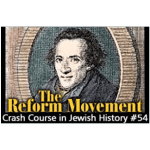History Crash Course #57: The Czars and the Jews
It is arguable which of the Russian Czars was the worst to the Jews. We’ll start with Czar Nicholas I (who ruled from 1825 to 1855) as one of the prime contenders and work our way down.
In 1827, Czar Nicholas I introduced what became known as the Cantonist Decrees. (The name came from the word “canton,” meaning “military camp.”) These decrees called for the forced conscription of Jewish boys into the Russian Army. These boys were between the ages of 12 and 18 and were forced to serve for 25 years! During their army service, every effort was made to convert them to Christianity.
Due to the horrendous conditions under which they were forced to serve, many of the boys who were conscripted didn’t survive, and if they did, few continued to identify themselves as Jews. As far as the Jewish community was concerned, either way was a death sentence.
Some Jewish parents were so desperate they would actually cut off the right index finger of their sons with a butcher’s knife ― without an index finger you couldn’t fire a gun and you were exempt from service. Other people would try and bribe their kid’s way out.
The Cantonist Decrees raise the level of pressure on the Jewish community to new extremes. Each Jewish community was responsible to produce a certain number of boys for the army and the community leadership was held responsible for failure to meet this quota. It’s not to hard to imagine the turmoil caused by forcing community leaders to decide which boys had to go and which boys could stay.
If that wasn’t bad enough, there was the government-sponsored anti-Semitism.
Protocols of the Elders of Zion
Around the turn of the century (It was first published in 1903), the Russian secret police began to circulate a forgery which became the most famous anti-Semitic “document” in history ― The Protocols of the Elders of Zion. These protocols purported to be the minutes of a secret meeting of world Jewish leaders, which supposedly took place once every hundred years for the purpose of plotting how to manipulate and control the world in the next century.
As ridiculous as this might sound to us today, the Protocols were seized upon as “proof” that the world was dominated by Jews who were responsible for all of the world’s problems.
Fans and proponents of the Protocols have included such anti-Semites as: Henry Ford, the founder of Ford Motor Company; Adolf Hitler, as might be expected; Egyptian President Gamal Abdel Nasser; and King Faisal of Saudi Arabia, among others.
Despite the fact that the Protocols are a proven forgery whose allegations are completely ridiculous, an expression of the worst kind of anti-Semitism, the Protocols continue to sell briskly today and are carried by such huge bookstore chains as Barnes and Noble and amazon.com in the name of freedom of speech.
Pogroms
We spoke of pogroms ― mob violence against Jews ― in Part 49 when we covered the murderous attacks of the Ukrainian Cossack Bogdan Chmielnicki in 17th century Poland.
In Czarist Russia, there were so many pogroms against the Jews that it is simply impossible to even begin to list them all. (In one four year period there were 284 pogroms, for example.)
These pogroms were seldom spontaneous, though incitement by Christian clergy around the Christian holidays could drive the masses into a frenzy. However, in Czarist Russia, most of the pogroms were government organized. Why would the Czarist government organize mobs to target Jews? Because Jews were the classic scapegoats for the economic problems of Russia (and many other countries in history).
Of course, the problems of Russia had nothing to do with the Jews. The problems of Russia had to do with a totally backward, feudal, and highly corrupt regime. One of the ways of diverting attention from the corruption was to blame the Jews and to allow the masses to blow off steam by taking it out on the Jews.
The problems of Russia got worse after Czar Alexander II (who was one of the more competent Czars and who was relatively benign to the Jews) was assassinated in 1881 by an anarchist who threw a bomb at his carriage. And when the problems of Russia got worse, the problems of the Jews got worse as well.
The government of the new Czar, Alexander III (who ruled 1881-1894) organized one pogrom after another to keep the anger of the masses focused on the Jews.
In addition to the pogroms, Alexander III promulgated a series of laws against the Jews. These laws were called the May Laws and they included such prohibitions as:
- “It is henceforth forbidden for Jews to settle outside the cities and townships.”
- “The registration of property and mortgages in the names of Jews is to be halted temporarily. Jews are also prohibited from administering such properties.”
- “It is forbidden for Jews to engage in commerce on Sundays and Christian holidays.”
Writes Berel Wein in Triumph of Survival (p. 173) of the reign of Alexander III:
“Expulsions, deportations, arrests, and beatings became the daily lot of the Jews, not only of their lower class, but even of the middle class and the Jewish intelligentsia. The government of Alexander III waged a campaign of war against its Jewish inhabitants… The Jews were driven and hounded, and emigration appeared to be the only escape from the terrible tyranny of the Romanovs.”
It did not help matters any that during the reign of Alexander III a terrible famine struck Russia in which 400,000 peasants died. Those who survived were bitter and their resentments grew (which would erupt eventually in an aborted revolution in 1905 and the successful Russian Revolution which ushered in Communist rule in 1917.)
The Last Romanov
When Alexander III died, he was succeeded by Nicholas II, the last of the Romanovs whose incompetence and inflexibility helped bring about the Russian Revolution. The new Czar had to cope with the mess left behind by his father and he did so badly.
During his reign one of the most famous pogroms took place ― in Kishinev, on Easter (April 6-7), 1903.
The Kishinev pogrom happened when there was a lot of tension in Russia (two years before the first, unsuccessful revolution). Wanting to dispel the tension, the Czarist government once again organized a pogrom against the Jews.
Strange as it may sound, the Kishinev pogrom received a lot of international attention. This was because by this time pogroms were something that the “enlightened” Western World no longer found acceptable. (If only they knew what they themselves would do to the Jews 40 years later!)
Here is an excerpt from a description of the pogrom printed in the New York Times:
“It is impossible to account the amounts of goods destroyed in a few hours. The hurrahs of the rioting. The pitiful cries of the victims filled the air. Wherever a Jew was met he was savagely beaten into insensibility. One Jew was dragged from a streetcar and beaten until the mob thought he was dead. The air was filled with feathers and torn bedding. Every Jewish household was broken into and the unfortunate Jews in their terror endeavored to hide in cellars and under roofs. The mob entered the synagogue, desecrated the biggest house of worship and defiled the Scrolls of the Law.
“The conduct of the intelligent Christians was disgraceful. They made no attempt to check the rioting. They simply walked around enjoying the frightful sport. On Tuesday, the third day, when it became known that the troops had received orders to shoot, the rioters ceased.”
After two days of mayhem, the Czar said, “Okay enough ― mission accomplished. Now it’s time to stop it.” And it stopped. 118 Jewish men, women and children were murdered, 1,200 were wounded and 4,000 families were rendered homeless and destitute. There were also 12,000 Russian soldier in the city who did nothing for two days.[1]Paul Mendes-Flohr & Yehuda Reinharz ed., The Jew in the Modern World, (Oxford University Press, 1995), p. 409.
Until the next time.
Between 1903 and 1907 was a period of great internal unrest in Russia. Nicholas’s incompetence coupled with excessive taxation and the humiliating defeat of Russia during the Russo-Japanese War (1904-05) let to the first Russian Revolution in 1905 which led to a few short-lived reforms in the government. This period also proved disastrous for the Jewish community there were 284 pogroms with over 50,000 casualties. The level of violence was unbelievable.
There was only so much of this kind of thing that people could take. The Jewish community was being devastated and people were looking for a way out. Jews were running out of the shtetls and joining all of the anarchist, communist, socialist, bundist movements that they could find in the hopes that they would be able to change the situation in Russia. Jews have been history’s great idealists and during this time they were desperate to find some way of making things better. (We will cover their activism when we discuss the events surrounding World War I.)
Another thing that was happening in this time period was emigration. We see mass emigration of Jews out of Russia. Between 1881 and 1914, some 50,000 or more Jews left every year to a estimated total of 2.5 million Jews.
Despite these migrations, the Jewish population of Russia stayed constant ― at about 5 million Jews, due the very high birthrate. Had these Jews not left Russia there would have been 7-8 million Jews there.
And it was America which absorbed most of the Jewish immigrants during this period of time.
Golden Land
We might recall (from Part 23) when the Jews were exile by the Babylonians, the exile had happened in two stages. First the Babylonians took away 10,000 of the best and the brightest, and that turned out to be a blessing in disguise because when the Jews arrive in Babylon, there is a Jewish infrastructure in place. Yeshivas had been established, synagogues built, there was a kosher butcher and a mikveh. Jewish life could continue and as a result we saw hardly any assimilation during the Babylonian exile.
However, when the poor Jews of Russia arrived en masse in America at the end of the 19th century ― passing through the famous Ellis Island ― they found no Jewish infrastructure in place. The Jews who had preceded them in the migration of the 1830s were German Jews (about 280,000 of them). These German Jews ― who resented the poorer Russian Jews ― were either Reform, (and did not believe that the Torah was God-given nor in any specific God-given law that Jews had to keep) or they were secular Jews who totally eschewed Jewish tradition. Thus, the poor Russian Jews stepped into the Golden Land of Assimilation as we shall see in the next installment.
References
| ↑1 | Paul Mendes-Flohr & Yehuda Reinharz ed., The Jew in the Modern World, (Oxford University Press, 1995), p. 409. |
|---|










